Blog
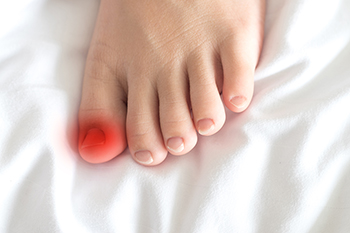
An ingrown toenail occurs when the edge of the nail grows into the surrounding skin, causing pain, swelling, and sometimes infection. This condition is commonly caused by improper nail trimming, tight footwear, injury, or inherited nail shape. Symptoms include redness, tenderness, and sometimes drainage or pus around the nail. Risk factors include poor foot hygiene, curved toenails, and repeated pressure on the toes. A chiropodist can assess the severity, provide relief through gentle nail care or minor procedures, and offer advice on preventing recurrence. If you notice signs of an ingrown toenail, do not ignore the discomfort. If you have developed this condition, it is suggested that you schedule an appointment with a chiropodist to treat the problem early and protect your foot health from complications.
Ingrown toenails may require medical attention. If you have significant pain or notice signs of infection from an ingrown toenail, please consult with one of the specialists from Thornhill Foot Clinic. Our chiropodists will assess your condition and provide you with quality foot and ankle treatment.
What Is an Ingrown Toenail?
An ingrown toenail occurs when the edges of a toenail grow into the surrounding skin. The toenails of the big toe are usually affected, however, an ingrown toenail can happen on any toe. Sometimes, the area can become infected leading to potentially serious complications. The ingrown toenail may be caused by improper trimming of the toenail, wearing ill-fitting shoes, or injury to the nail.
Symptoms
The symptoms of an ingrown toenail include:
Pain
Swelling
Redness
Warmth
Pus or drainage from the affected nail or a fever may indicate an infection of the area.
Treatment
Treatment depends on the severity of the ingrown toenail. In less severe cases, home treatment may be adequate. Soaking the affected foot in warm water and gently lifting the nail from the skin with a piece of clean cotton can help. In more severe cases, you may need to use topical or oral antibiotics to treat an infection. Surgical removal of the ingrown toenail may be required if more conservative treatments fail.
Ingrown toenails may be prevented by wearing well-fitted shoes and properly trimming the toenails. Toenails should be trimmed straight across and not too short when using nail clippers.
If you have any questions, please feel free to contact our office located in . We offer the newest diagnostic and treatment technologies for all your foot care needs.
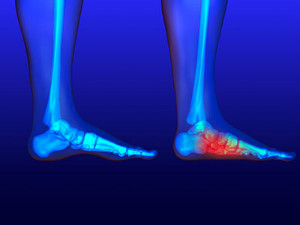
Running with flat feet can present challenges, but with the right approach, it can be safe and enjoyable. Flat feet may cause overpronation, leading to discomfort or injury without proper support. Choosing running shoes with firm arch support and stability features can help maintain alignment and reduce strain. Gradual training with attention to form and strength exercises can also improve performance and prevent injury. A chiropodist can assess foot mechanics, recommend custom orthotics, and guide proper footwear choices to support your running goals. If you experience discomfort while running or suspect flat feet are affecting your stride, it is suggested that you consult a chiropodist for an expert evaluation and a personalized plan to keep you active and pain free.
Flat feet are a common foot condition. If you are experiencing pain or discomfort due to flat feet, please consult with one of the specialists from Thornhill Foot Clinic. Our chiropodists will assess your condition and provide you with quality foot and ankle treatment.
What Are Flat Feet?
Flat feet are feet that do not have a well-defined arch in the middle of the sole of the foot. Flat feet may be flexible or rigid. Flexible flat feet have an arch when there is no pressure put on the foot, such as when one is sitting, but the arch disappears upon standing. Rigid flat feet lack an arch regardless of whether one is standing or not.
Causes
Flat feet can be present from birth or acquired over time due to a weakening of the ligaments in the arch. Sometimes flat feet are caused by illnesses, injuries, or pregnancy.
Symptoms
Flat feet often cause no noticeable symptoms. However, some people may experience pain and discomfort due to their flat feet.
Symptoms associated with flat feet include:
Pain in the arch, heel, ankle, or along the outside of the foot
Overpronation of the foot
Shin splints
Aching or fatigue in the feet or legs
Pain in the knees, hips, or lower back
Treatment
In cases where flat feet cause symptoms, there are various treatments available. Wearing orthotic inserts in your shoes to provide more arch support, performing stretches, and taking medications may improve your symptoms. If you are overweight, losing weight can help relieve pressure on the feet. In severe cases, surgery may be considered.
If you have any questions, please feel free to contact our office located in . We offer the newest diagnostic and treatment technologies for all your foot care needs.
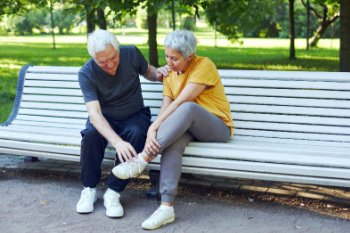
Foot pain is a common issue among seniors due to several factors that develop with age. One major cause of foot pain in seniors is wearing poorly fitting shoes, which may be too tight, too narrow, or lack proper support. Shoes that do not fit well can lead to discomfort, injury, or increased risk of falls. Over time, the natural structure of the foot also changes. The padding under the heel and ball of the foot thins out, arches lose flexibility, and joints may become stiff. Feet often grow wider and longer, and dry skin becomes more common, making the skin more prone to irritation or infection. Health conditions that can increase the risk of foot pain include diabetes, arthritis, nerve damage, and poor circulation. Extra strain from excess weight, jobs that require long hours of standing, or walking on hard surfaces can also lead to discomfort. A chiropodist can help identify the source of the foot pain and provide personalized care. If you are experiencing foot problems, it is suggested that you schedule an appointment with a chiropodist for an accurate diagnosis and effective treatment solutions.
Foot problems can become increasingly common as we age, making everyday foot care especially important. To learn more about maintaining proper foot health, please consult with one of the specialists from Thornhill Foot Clinic. Our chiropodists will assess your condition and provide you with quality foot and ankle treatment.
Common Foot Problems
Certain foot problems may be more likely to affect older adults.
Some examples of foot conditions that can be common in older adults include:
Dry, cracked skin
Calluses and corns
Blisters
Ingrown toenails
Deformities such as bunions or hammertoes
Fungal infections
Plantar warts
Systemic conditions, such as diabetes or arthritis, are also more likely to affect older people and manifest symptoms in the feet and ankles.
Daily Foot Care Tips
Having a daily foot care routine can help detect problems early on and prevent future issues.
Things that you can do at home to care for your feet include:
Washing the feet daily with warm water, drying them thoroughly, and then applying a moisturizer
Trimming the toenails straight across and not too short to prevent ingrown toenails
Performing daily foot exercises to improve foot strength and mobility
Wearing shoes when walking to avoid injury
Inspecting the feet daily for any cuts, scrapes, sores, or other abnormalities and seeking prompt treatment if any problems are discovered
If you have any questions, please feel free to contact our office located in . We offer the newest diagnostic and treatment technologies for all your foot care needs.
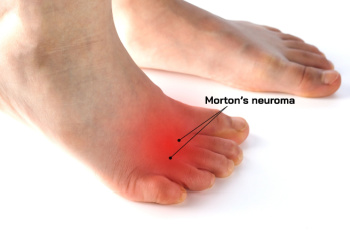
Morton's neuroma is a painful condition involving the thickening of tissue around a nerve in the foot, most commonly between the third and fourth toes. This pressure on the nerve causes irritation and inflammation. It can develop from wearing tight or high-heeled shoes, repetitive stress from sports, or foot deformities such as bunions or flat feet. Symptoms often include a sharp or burning pain in the ball of the foot, tingling, numbness, or the feeling of standing on a small object. Risk factors include improper footwear, high-impact activities, and abnormal foot structure. A chiropodist can help by performing a physical examination, recommending footwear changes, providing custom orthotics, and offering conservative treatments to relieve pressure, reduce pain, and improve foot function. If you have pain in this part of your foot, it is suggested that you consult a chiropodist for a diagnosis and treatment plan.
Morton's neuroma can be highly uncomfortable. If you are experiencing the symptoms of Morton's neuroma, please consult with one of the specialists from Thornhill Foot Clinic. Our chiropodists will assess your condition and provide you with quality foot and ankle treatment.
What Is a Morton’s Neuroma?
Morton’s neuroma is a condition in which a nerve located in the ball of the foot between the third and fourth toes thickens due to compression or irritation. Common causes of Morton’s neuroma include wearing shoes with high heels or narrow toe boxes, participating in running or court sports, an injury or trauma to the area, or pressure being placed on the nerve from foot deformities such as bunions or hammertoes. Left untreated, Morton's neuroma may result in permanent nerve damage.
Symptoms
Symptoms of Morton’s neuroma often start gradually and worsen over time. Typical symptoms include:
Foot pain
Tingling, burning, or numbness in the affected foot
The unique sensation that something is inside the ball of the foot or that there is something stuck in your shoe while walking
Treatment
Non-surgical treatments for this condition may include padding or icing the affected foot, wearing an orthotic device, modifying activities or shoes to reduce pressure on the foot, and taking medications or getting injections to reduce pain and inflammation. Surgery may be needed if non-surgical treatments are ineffective.
If you have any questions, please feel free to contact our office located in . We offer the newest diagnostic and treatment technologies for all your foot care needs.
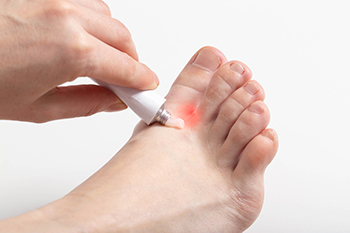
Athlete's foot is a fungal infection that affects the skin on the feet, particularly between the toes. It is caused by fungi that thrive in warm, moist environments, such as locker rooms, communal showers, and damp footwear. Symptoms often include itching, redness, peeling skin, and a burning sensation. In more severe cases, the skin may crack or blister. Risk factors include wearing tight or damp shoes, walking barefoot in public places, and having a weakened immune system. A chiropodist can diagnose the condition, recommend antifungal treatments, and provide guidance on preventing recurrence. Proper foot hygiene, drying the feet thoroughly, and wearing breathable footwear are essential steps. If you have any of the above symptoms, it is suggested that you promptly contact a chiropodist who can provide appropriate treatment solutions.
Athlete’s foot can be uncomfortable and unsightly. To learn more about preventing and treating this condition, please consult with one of the specialists from Thornhill Foot Clinic. Our chiropodists will assess your condition and provide you with quality foot and ankle treatment.
What Is Athlete’s Foot?
Athlete’s foot refers to an infection of the skin on the feet that is caused by a fungus. This fungus is contagious and thrives in warm and moist environments. It is often spread in common areas such as public pools, locker rooms, and showers. It can also spread when sharing personal items, like shoes or towels, with an infected person.
Symptoms
The symptoms of athlete’s foot may include:
Itching, stinging, or burning of the skin on the feet
Cracking or peeling skin, especially between the toes and on the soles of the feet
Scaly, red rash on the foot
Blisters
Foul odor
Treatment
Treatment for athlete’s foot typically involves using over-the-counter topical antifungal medications on the feet. When over-the-counter options are ineffective, you may need to take prescription oral medications or topical antifungal drugs, or a combination of both.
Prevention
Preventing athlete’s foot places an emphasis on good foot hygiene practices.
You can prevent athlete’s foot by:
Washing and drying your feet thoroughly every day
Wearing shoes when walking in public areas
Not sharing personal items, like shoes or socks, with others
Wearing shoes and socks made out of breathable materials
If you have any questions, please feel free to contact our office located in . We offer the newest diagnostic and treatment technologies for all your foot care needs.

Plantar fasciitis often begins as inflammation, but over time, it can shift into a degenerative condition. Instead of temporary irritation, the tissue in the arch begins to break down due to repeated stress and lack of healing. This is known as degenerative plantar fasciitis, and it tends to cause more chronic, deep heel pain. The discomfort is often worse in the morning or after long periods of rest. Unlike early-stage plantar fasciitis, inflammation is no longer the main issue, so typical treatments like rest may offer limited relief. Exercises focused on strengthening, stretching, and improving blood flow become more important. Advanced cases may benefit from wearing specialized footwear, custom orthotics, or regenerative exercise. If heel pain is ongoing and not responding to basic care, it is suggested that you see a chiropodist for advanced treatment.
Plantar fasciitis can be painful and interfere with your daily activities. If you are experiencing foot or heel pain and believe you may be afflicted with plantar fasciitis, please consult with one of the specialists from Thornhill Foot Clinic. Our chiropodists will assess your condition and provide you with quality foot and ankle treatment.
What Is Plantar Fasciitis?
Plantar fasciitis refers to the inflammation of the plantar fascia, a ligament that runs along the bottom of the foot and connects the heel bone to the toes. Repetitive activities, such as running or jumping, can injure the plantar fascia over time. Plantar fasciitis can also be caused by flat feet, high arches, pregnancy, and activities that put excessive pressure on your feet, like standing all day for work. When the plantar fascia becomes inflamed, it causes pain and discomfort.
Symptoms
Typical symptoms of plantar fasciitis include:
Stabbing pain near the heel
Pain that is worst in the morning or after a period of rest
Pain that increases after exercising
Swelling
Tightness in the Achilles tendon
Diagnosis
Plantar fasciitis is typically diagnosed via medical history and physical examination.
Treatment
Treatments for plantar fasciitis include resting and icing the affected foot, stretching the foot, taking medications to reduce inflammation, and wearing orthotics. In severe cases where pain does not improve with conservative treatments, injections or surgery may be recommended.
If you have any questions, please feel free to contact our office located in . We offer the newest diagnostic and treatment technologies for all your foot care needs.
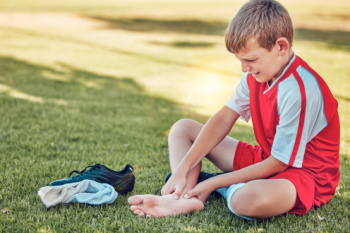
Sever’s disease, also called calcaneal apophysitis, is a common cause of heel pain in adolescent children, especially those involved in sports like football, basketball, or gymnastics. Sever’s disease occurs when the heel bone grows faster than the muscles and tendons around it. This leads to increased tension and inflammation at the growth plate where the Achilles tendon attaches. This condition tends to affect children during growth spurts and is more common in boys. Symptoms include heel pain, swelling, tenderness, and discomfort that worsens with activity and improves with rest. Some children may walk on their toes to avoid putting pressure on the heel. Diagnosis is typically based on a physical exam, often by gently squeezing the sides of the heel to check for pain. A chiropodist can assess your child’s foot structure, recommend footwear, provide orthotic inserts, and guide a safe return to activity. If your child complains of heel pain after sports activities, it is suggested that you schedule an appointment with a chiropodist for guidance.
Sever’s disease typically affects young children and teenagers. If your child complains of foot pain, please consult with one of the specialists from Thornhill Foot Clinic. Our chiropodists will assess your condition and provide you with quality foot and ankle treatment.
What Is Sever’s Disease?
Sever’s disease, also known as calcaneal apophysitis, is an inflammation of the growth plate in the heel bone. It is typically caused by overuse due to repetitive activities such as running, jumping, and playing certain sports. This condition most frequently affects children between the ages of 8 and 14.
Symptoms
Symptoms of Sever’s disease include:
Pain in the back or bottom of the heel
Pain when the sides of the heel are squeezed
Limping or walking on tiptoes to avoid putting pressure on the heel
Difficulty running, jumping, or participating in usual activities
Fatigue
Diagnosis
Sever’s disease is diagnosed by taking a thorough medical history and performing a physical examination. Imaging studies, such as an X-ray, can help rule out other injuries like a fracture.
Treatment
Sever’s disease typically heals without any long-term complications. Treatment involves resting the affected foot by reducing typical activities, wearing orthotics to support the foot, immobilizing the affected foot, taking medications to reduce pain and inflammation, and stretching the foot.
If you have any questions, please feel free to contact our office located in . We offer the newest diagnostic and treatment technologies for all your foot care needs.

Peripheral neuropathy is a condition that results from damage to the peripheral nerves, often causing a range of unsettling symptoms. Individuals may experience tingling, burning, or prickling sensations, often beginning in the feet and gradually spreading upward. Numbness and a reduced ability to feel pain or temperature changes are also common. Some people report a sensation similar to wearing gloves or socks when they are not. Muscle weakness, cramping, and difficulty with coordination can make simple movements challenging. In some cases, sharp, jabbing, or throbbing pain may occur, especially at night. Sensitivity to touch may increase, and even light contact can feel uncomfortable. If you have symptoms of neuropathy in your feet, it is suggested that you schedule an appointment with a chiropodist who can offer effective relief and treatment solutions.
Neuropathy can cause permanent nerve damage if left untreated. If you are experiencing the symptoms of peripheral neuropathy, please consult with one of the specialists from Thornhill Foot Clinic. Our chiropodists will assess your condition and provide you with quality foot and ankle treatment.
What Is Peripheral Neuropathy?
Peripheral neuropathy is a condition that damages the nerves of the peripheral nervous system, which provide sensation to the limbs. The feet are often affected. Peripheral neuropathy can have many different causes, but it is most commonly associated with diabetes.
Symptoms
Common symptoms of peripheral neuropathy include:
Pain
Numbness or tingling sensation
Burning sensations
Weakness
Loss of balance
Diagnosis
Peripheral neuropathy is diagnosed based on medical history and physical examination. Various tests performed during physical examinations can help determine the type of peripheral neuropathy you may have and what is causing it.
Treatment
Treatment for peripheral neuropathy will depend on what is causing it. For example, if your peripheral neuropathy is caused by diabetes, then managing your blood sugar, exercising regularly to strengthen the legs and feet, and taking pain medications may be recommended as treatments.
If you have any questions, please feel free to contact our office located in . We offer the newest diagnostic and treatment technologies for all your foot care needs.
Blog Archives
- 2025
- 2024
- 2023
- 2022
- 2021


